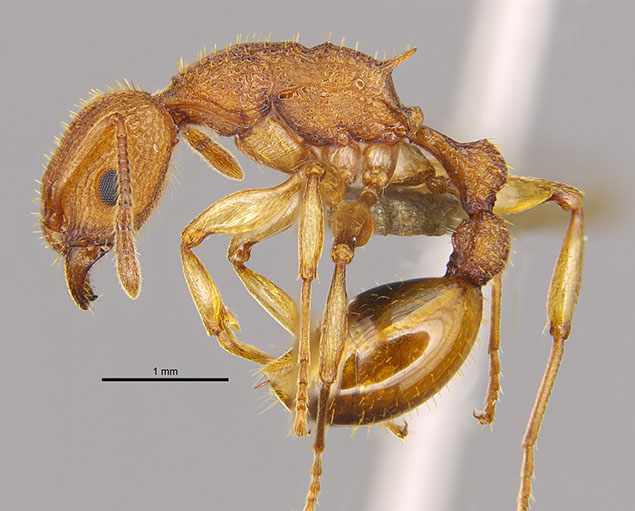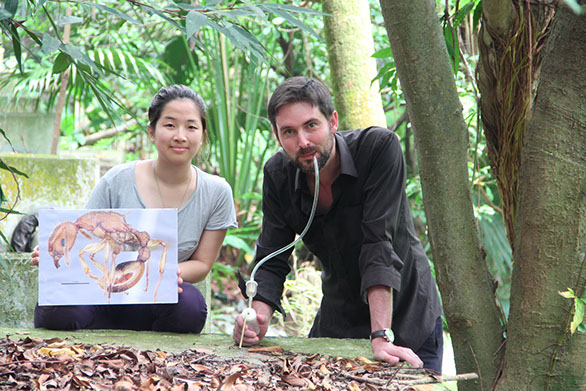
City Life
It seems only fitting that a new species of ant discovered in Hong Kong was not found in a rural setting but in the city’s urban jungle – just a short distance from the HKU campus.
Paratopula bauhinia, the new ant species described from Hong Kong by HKU biologists.
The ant was discovered by Ms Ying Luo, a research assistant with the Insect Biodiversity and Biogeography research group led by Dr Benoit Guénard at the School of Biological Sciences. It was found in Lung Fu Shan Country Park which is Hong Kong’s smallest park and is set close to urban surroundings on Hong Kong Island.
“We were doing a nighttime field trip, part of the Insect Ecology course,” said Dr Guénard. On the way back Ms Luo noticed a really cool ant – unusually large at about 7mm long and golden in colour. We went straight back to the laboratory to examine it more closely.”
They realised that the specimen represented the first record of the ant genus Paratopula for Hong Kong and southern China, as well as a new species. What marks the species apart from others is the shape of its spines; the number of teeth on mandible (10); and the properties and shape of the thorax.
A new species is a new species for science, while a new record is a species or genus already described but not found in this location. Here the genus has been described before but not this species. The research team’s new discovery represents the 22nd ant species described from Hong Kong since 1858. The last one was in 2000 and all the previous ones dated back from 1928 and earlier.
“It is an exciting discovery,” said Dr Guénard. “Most people will never find a new species in their life. When you describe a new species you have contributed to the catalogue of life on Earth. In research, sometimes findings may later be shown to be inaccurate or are superseded, but naming a species is eternal. It’s also a fantastic contribution for Hong Kong. We are working on producing the first inventory of ants in the city – presenting their diversity, distribution and commonness in the region; and naturally this new species will be included within this larger benchmark.”
The new species has been given the scientific name Paratopula bauhinia in Asian Myrmecology, a peer-reviewed, yearly journal dedicated to the study of Asian ants. The species part of the name, ‘bauhinia’, is a reference to the flower which is the symbol of Hong Kong and also a reference to the arboreal nature of the species which seems to live on trees and forage only at dusk and at night.
There are other implications for the discovery. “When you describe a new species, usually you don’t know anything about this new organism,” said Dr Guénard. You need to study it, work out its
ecology – it could be indicative of a disturbed development, or play an important role within the ecosystem. There may be so much more to discover – it may produce a specific molecule that could have incredible medical properties – who knows?
“Taxonomy is only the first stone of a wall that could be much larger – further study is required to find out how large, but the point is you’re the first to study it. With a new discovery, at the very least what has changed is that you have clearly set its description, which later on will allow it to be differentiated from all other species, which we have done by updating the taxonomy key of the genus.”

![]() Hong Kong is heavily urbanised and most people might assume that everything is known about our surroundings, but many species are still unrecorded or unknown. It seems strange to me that a virtual game like Pokémon Go encounters such success when it is really just a light virtual version of what we ecologists do. We search for new creatures (organisms) and study them.
Hong Kong is heavily urbanised and most people might assume that everything is known about our surroundings, but many species are still unrecorded or unknown. It seems strange to me that a virtual game like Pokémon Go encounters such success when it is really just a light virtual version of what we ecologists do. We search for new creatures (organisms) and study them. ![]()
Dr Benoit Guénard
The real game
He goes on to explain that while the Paratopula bauhinia is just one example and taken alone is not that significant, what it signifies is how little we know about our environment. “Around the world new species are found every day, about 18,000 species of plants or animals are described annually, and millions are still to be found and described. Hong Kong is heavily urbanised and most people might assume that everything is known about our surroundings, but many species are still unrecorded or unknown. It seems strange to me that a virtual game like Pokémon Go encounters such success when it is really just a light virtual version of what we ecologists do. We search for new creatures (organisms) and study them.
“The difference is we are playing the real game. Maybe this discovery will inspire Pokémon players and others to realise they can do the same thing in the real world and make a useful contribution to science while feeling proud of their own true discovery. And we must hurry because major parts of natural habitats are disappearing, so describing new species before they disappear is particularly important.”
In 2016, the Insect Biodiversity and Biogeography research group has described four new species in all – Paratopula bauhinia in Hong Kong and three in Singapore, another heavily urbanised area, though unlike Hong Kong it still has small remnants of primary forest. The group also has several other specimens that potentially represent new species – but will require more work to describe them.
“This is the first one, but it’s just the tip of the iceberg,” said Dr Guénard. “Several laboratories at HKU are describing new species – be they insects, crustaceans or plants. As a scientist I understand the excitement of finding life on new planets, however we need to be pragmatic and realise that the emergency is right here on Earth. Around 80 per cent of life on this planet is estimated to still be unknown. While species are disappearing at an alarming rate, some most likely before we can even describe them, actions to describe, study and protect this incredible potential have to be taken very seriously.”

Ms Ying Luo (left) and Dr Benoit Guénard (right) at the Lung Fu Shan site where the Golden Tree Ant Paratopula bauhinia was first discovered.


